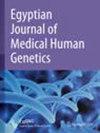Turkish population-based screening for first identified changes of BRCA1 and BRCA2 genes in breast and/or ovarian cancer patients
IF 1.2
Q4 GENETICS & HEREDITY
引用次数: 0
Abstract
It is known that BRCA1 and BRCA2 genes’ mutation carriers are predisposed to breast and ovarian cancers and other organ cancers such as prostate, colon and cervix. In the previous study performed at X University, all coding exons of both genes were screened by denaturing gradient gel electrophoresis (DGGE). In addition to various nonsense, missense mutations, polymorphisms and intronic region changes, seven novel missense mutations, including H513L, H816P and S1517Y in BRCA1 and S326R, G258P, E2903K and N2742S in BRCA2, had been identified. To determine whether these unclassified variants are pathogenic, DNA samples of 150 healthy individuals without a known cancer history in the family were screened in this study for these seven novel missense mutations. These DNA samples were recruited from archives of previous polymorphism studies. PCR performed DNA amplifications, and denaturing high-performance liquid chromatography (DHPLC) techniques did mutation screenings. Peak patterns suggestive of a change in DNA fragments were considered for sequencing analyses. Analyses revealed that none of the 150 DNA samples had any change in the seven screened fragments. As a result, it is assumed that these seven mutations might be novel pathogenic mutations described in the Turkish population. In conclusion, these carriers must be informed about the mutation and given appropriate genetic counseling by their physicians. In addition, genetic testing must be offered to high-risk individuals (men/women) in the family so that it would be possible for other family members to have genetic counseling and contribute to disease prevention. On the other hand, these findings would contribute to current literature with novel results and shed light on future research.以土耳其人口为基础,筛查乳腺癌和/或卵巢癌患者中首次发现的 BRCA1 和 BRCA2 基因变化
众所周知,BRCA1 和 BRCA2 基因突变携带者易患乳腺癌、卵巢癌和其他器官癌症,如前列腺癌、结肠癌和宫颈癌。在 X 大学之前进行的研究中,通过变性梯度凝胶电泳(DGGE)筛选了这两个基因的所有编码外显子。除了各种无义突变、错义突变、多态性和内含子区变化外,还发现了七种新型错义突变,包括 BRCA1 中的 H513L、H816P 和 S1517Y,以及 BRCA2 中的 S326R、G258P、E2903K 和 N2742S。为了确定这些未分类的变异是否具有致病性,本研究对 150 个没有已知家族癌症病史的健康人的 DNA 样本进行了筛查,以检测这 7 个新型错义突变。这些 DNA 样本是从以前的多态性研究档案中收集的。聚合酶链式反应(PCR)进行 DNA 扩增,变性高效液相色谱(DHPLC)技术进行突变筛选。对提示 DNA 片段发生变化的峰值模式进行测序分析。分析表明,在 150 份 DNA 样本中,7 个筛选出的片段均未发生任何变化。因此,推测这七种突变可能是土耳其人群中出现的新型致病突变。总之,医生必须告知这些基因突变携带者,并为他们提供适当的遗传咨询。此外,还必须为家族中的高危个体(男性/女性)提供基因检测,以便其他家庭成员也能接受基因咨询,为疾病预防做出贡献。另一方面,这些研究结果将为目前的文献提供新的成果,并为未来的研究提供启示。
本文章由计算机程序翻译,如有差异,请以英文原文为准。
求助全文
约1分钟内获得全文
求助全文
来源期刊

Egyptian Journal of Medical Human Genetics
Medicine-Genetics (clinical)
CiteScore
2.20
自引率
7.70%
发文量
150
审稿时长
18 weeks
 求助内容:
求助内容: 应助结果提醒方式:
应助结果提醒方式:


